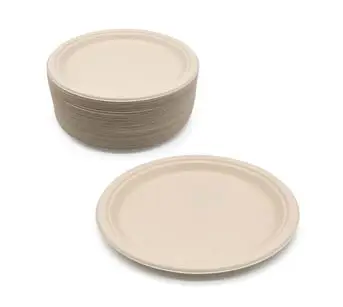With the increasing awareness of environmental concerns and the need for sustainable practices, the food industry has been compelled to reassess its packaging options. In this context, biodegradable takeaway containers have emerged as a viable solution.
These containers are designed to break down naturally into non-toxic components over time, reducing the environmental impact associated with traditional plastic containers. By exploring the definition, importance in the food industry, and various aspects of biodegradable takeaway containers, we can gain a comprehensive understanding of their potential benefits and challenges.
Definition of Biodegradable Containers
Biodegradable takeaway containers refer to packaging materials that have the ability to decompose naturally into simpler substances through biological processes like composting or microbial action. Unlike conventional plastic containers that can persist in landfills for hundreds of years, biodegradable alternatives break down into harmless elements within a relatively shorter timeframe.
Importance of Sustainable Packaging in the Food Industry
Sustainable packaging plays a crucial role in addressing some of the most pressing environmental challenges faced by the food industry today. With mounting concerns about plastic pollution and its detrimental impact on ecosystems, there is an urgent need for businesses to adopt eco-friendly alternatives like biodegradable takeaway containers. Such sustainable packaging solutions help reduce waste generation while minimizing carbon emissions associated with production and disposal processes.
Compostable takeaway food containers are a prime example of sustainable packaging solutions that address the environmental challenges posed by plastic pollution. These containers offer businesses an eco-friendly alternative that not only reduces waste generation but also helps decrease carbon emissions throughout the entire lifecycle of the packaging, from production to disposal. By adopting compostable takeaway food containers, businesses can actively contribute to a more sustainable and environmentally conscious food industry.
Purpose of the Outline: Exploring Various Aspects
The purpose of this outline is to delve into various aspects related to biodegradable takeaway containers. By examining their definition, significance within the food industry, types available, benefits they offer as well as potential challenges faced during their implementation and adoption, we aim to provide a detailed analysis that will assist individuals and businesses in making informed decisions regarding sustainable packaging choices.
Overview of Biodegradable Takeaway Containers
Definition and Characteristics
Biodegradable takeaway containers refer to packaging materials specifically designed to break down naturally into non-toxic components over time. Unlike traditional plastic containers derived from fossil fuels, these innovative alternatives are created using materials such as plant-based resources or compostable polymers.
The primary characteristic of biodegradable takeaway containers lies in their ability to undergo decomposition through natural processes, such as microbial action or exposure to environmental elements like heat, moisture, and oxygen. This decomposition occurs without leaving behind harmful residues or contributing to long-lasting pollution.
Materials Used (e.g., Plant-Based, Compostable Polymers)
Biodegradable takeaway containers are manufactured using a range of materials, each with its own unique properties and sustainability benefits. Plant-based containers are crafted from renewable resources such as cornstarch, sugarcane bagasse, or bamboo fibers.
These materials offer a viable alternative by reducing reliance on fossil fuels and minimizing environmental impact during production. Additionally, compostable polymers derived from natural sources are processed into durable packaging materials that possess similar characteristics to conventional plastics but can decompose under specific conditions.
Ability to Break Down Naturally into Non-Toxic Components
One distinguishing feature of biodegradable takeaway containers is their innate ability to disintegrate over time without leaving behind harmful byproducts. These containers break down naturally through various biological and chemical processes that convert them into non-toxic components.
For instance, microbial activity plays a significant role in the decomposition process as microorganisms present in the environment consume the organic matter within the container structure. This breakdown results in harmless substances such as water vapor, carbon dioxide, and organic biomass that can safely reintegrate into the ecosystem.
Advantages Over Traditional Plastic Containers
Biodegradable takeaway containers offer several advantages over traditional plastic containers, making them a more sustainable choice for the environment and businesses alike. Firstly, their usage leads to a reduced environmental impact and waste generation. Biodegradable materials minimize the accumulation of plastic waste in landfills or oceans, where traditional plastics may persist for hundreds of years without decomposition.
By adopting biodegradable alternatives, businesses can actively contribute to curbing plastic pollution and protecting ecosystems. Furthermore, biodegradable takeaway containers have the potential for composting or recycling.
Unlike conventional plastics that often end up in landfills due to limited recycling capabilities, biodegradable containers can be diverted into composting or specialized recycling facilities. Composting converts these materials into nutrient-rich soil amendments that support sustainable agriculture practices.
Compostable sugarcane containers offer a viable solution to the issue of plastic waste that often ends up in landfills. These containers can be diverted into composting facilities, where they break down naturally and contribute to the production of nutrient-rich soil amendments, fostering sustainable agricultural practices. By choosing compostable sugarcane containers, businesses can support a circular economy and minimize the negative environmental impact of single-use packaging.
Recycling options enable the reuse of the material for manufacturing new products, closing the loop on resource consumption and waste generation. Overall, these advantages position biodegradable takeaway containers as an effective solution to reduce environmental harm caused by single-use packaging while promoting more sustainable practices within the food industry.
Plant-based Containers: A Sustainable Solution
One type of biodegradable takeaway container gaining popularity is plant-based containers. These innovative packaging options are made from renewable resources like cornstarch, sugarcane bagasse, or bamboo fibers. By utilizing such materials, these containers offer a sustainable alternative to conventional plastic packaging.
Not only are they biodegradable, but they are also compostable, meaning they can break down naturally into non-toxic components when subjected to the right conditions. Plant-based containers have shown great potential in reducing the environmental impact caused by traditional plastic containers.
Since they are derived from renewable resources, their production involves lower energy consumption and carbon emissions compared to their plastic counterparts. Furthermore, these containers can be effectively processed in industrial composting facilities.
Compostable Polymers Containers: Balancing Durability and Decomposition
In addition to plant-based containers, another type of biodegradable takeaway container gaining attention is compostable polymers containers. These packaging materials are derived from natural sources but undergo processing to create durable alternatives that retain their functional properties while still being able to decompose under specific conditions.
To ensure proper decomposition of compostable polymer containers, specific conditions must be met. Typically, commercial composting facilities maintain high temperatures and controlled environments that facilitate the breakdown of these materials into non-toxic substances.
This process allows for efficient management of waste as the resulting organic matter can be utilized as nutrient-rich compost for agriculture or horticulture. Overall, both plant-based and compostable polymers containers contribute significantly to reducing our dependence on traditional plastic packaging solutions and offer a more sustainable option for the food industry's takeaway needs.
Each one has its unique advantages and considerations regarding production methods and disposal infrastructure. By embracing these innovative alternatives, businesses can take meaningful steps towards promoting environmental responsibility while meeting consumer demands for sustainable practices.
Benefits and Challenges of Biodegradable Takeaway Containers
A BenefitsReduced carbon footprint due to lower energy consumption during production compared to traditional plastic containers.
Biodegradable takeaway containers offer a significant advantage in terms of their reduced carbon footprint. Traditional plastic containers require extensive amounts of energy and resources for their production, including the extraction of fossil fuels and the manufacturing processes involved. In contrast, biodegradable containers often utilize plant-based materials that can be grown sustainably.
The production of these containers typically requires less energy, contributing to lower greenhouse gas emissions. By choosing biodegradable alternatives, businesses can actively reduce their environmental impact by minimizing carbon emissions associated with packaging manufacture. Potential reduction in landfill waste as they can break down into organic matter.
One of the most compelling benefits of biodegradable takeaway containers is their ability to break down naturally into organic matter when disposed of properly. Unlike conventional plastic containers that persist for hundreds or even thousands of years in landfills, biodegradable options help alleviate the burden on waste management systems.
When exposed to suitable conditions such as heat, moisture, and microbial activity found in dedicated composting facilities or home composting setups, these containers degrade into compost or nutrient-rich soil amendment. This natural decomposition process not only reduces the amount of waste sent to landfills but also supports the creation of a circular economy by providing valuable resources for agriculture and gardening. Promote a positive brand image for businesses that prioritize sustainability.
As sustainability becomes increasingly important to consumers, businesses that prioritize environmentally friendly practices gain a competitive edge by offering biodegradable takeaway container options. By adopting these alternatives over conventional plastics, companies demonstrate a commitment to reducing environmental harm and preserving natural resources. Such actions resonate with environmentally conscious consumers who value brands that align with their values.
By using biodegradable containers, businesses can communicate their commitment to sustainability, enhancing their reputation and fostering customer loyalty. Moreover, the positive brand image associated with eco-friendly practices can attract new customers who prioritize environmentally responsible choices.
B ChallengesLimited availability and higher costs compared to conventional plastic alternatives.
While the benefits of biodegradable takeaway containers are impressive, challenges exist that hinder their widespread adoption. One significant challenge relates to limited availability and higher costs compared to conventional plastic alternatives. Biodegradable materials often require specialized production processes and sourcing from renewable resources, which can increase manufacturing expenses.
Additionally, the demand for these containers may exceed the current supply capacity of manufacturers, leading to potential shortages in certain regions. As technology improves and economies of scale are achieved through increased production volumes, the availability and cost-effectiveness of biodegradable takeaway containers are likely to improve over time. Requirement for proper disposal infrastructure (composting facilities) which may not be readily accessible in all areas.
The successful decomposition of biodegradable takeaway containers relies on proper disposal infrastructure such as dedicated composting facilities or home composting setups. Unfortunately, these facilities may not be readily accessible in all areas.
This lack of infrastructure poses a challenge as improper disposal can undermine the environmental benefits associated with these containers. In regions where composting facilities are scarce or non-existent, biodegradable packaging may end up in general waste streams or traditional landfills where they may degrade slowly or not at all.
To fully realize the potential advantages of biodegradable takeaway containers, it is crucial to develop comprehensive waste management systems that support widespread access to appropriate disposal methods. Overall, while biodegradable takeaway containers offer various benefits such as reduced carbon footprint and potential reduction in landfill waste while promoting a positive brand image for businesses prioritizing sustainability; challenges like limited availability and higher costs compared to conventional plastic alternatives, along with the requirement for proper disposal infrastructure, need to be addressed for a more effective adoption of this eco-friendly solution.
Niche
Challenges and Opportunities in the Market
The biodegradable takeaway container market holds immense potential for growth and innovation. As society becomes more environmentally conscious, consumers are actively seeking sustainable alternatives to traditional plastic packaging. This demand creates a niche market that can be tapped into by businesses looking to make a positive impact while meeting consumer needs.
The demand for sustainable packaging solutions extends beyond takeaway containers to include biodegradable serving bowls. As businesses recognize this market potential, there is an opportunity for growth and innovation in the biodegradable serving bowl sector, allowing companies to cater to environmentally conscious consumers while making a positive contribution to the reduction of plastic waste. By embracing this market, businesses can align their practices with the growing sustainability movement and meet the needs of consumers seeking eco-friendly alternatives.
However, there are challenges to navigate within this niche. Firstly, the availability and affordability of biodegradable containers may initially limit their widespread adoption.
Additionally, the requirement for proper disposal infrastructure, such as industrial composting facilities, might not be accessible in all areas. Nevertheless, these challenges create opportunities for entrepreneurs and investors to develop new solutions that bridge these gaps and drive the expansion of the biodegradable takeaway container industry.
Biodegradable takeaway containers offer a promising solution to the environmental concerns associated with traditional plastic packaging in the food industry. While there are challenges such as limited availability and higher costs compared to conventional options, innovation within this niche presents opportunities for growth and increased accessibility.
By choosing biodegradable containers over their plastic counterparts, businesses can significantly reduce their carbon footprint while promoting a positive brand image aligned with sustainability values. As consumers become more conscious about their environmental impact, the demand for eco-friendly packaging will continue to rise.
The shift towards sustainable practices not only benefits our planet but also resonates with socially responsible consumers who prioritize businesses that demonstrate environmental stewardship. With ongoing research and development efforts focused on improving production capabilities and reducing costs, we can expect an even wider range of affordable biodegradable takeaway containers in the future.
By embracing biodegradability as a core principle in packaging choices, businesses have the power to contribute towards a cleaner environment without compromising on quality or convenience. Together we can create a future where nature thrives alongside human progress – one meal at a time.




